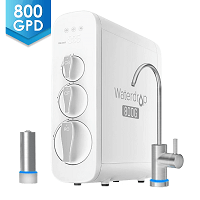Struggling to improve water quality continues long after a water crisis has taken
place. As history tells us, even
Flint,
Michigan has struggled since their own water supply was threatened back in 2014. Then, in 2019, Newark,
NJ made headlines of their own, with a lead water crisis that effected 1/5 of its entire citizenship. As their
residents began grow concerned, fearing Flint, Michigan was on repeat, Newark official went to work creating a
plan. In fact, the folks in Newark quickly began replacing their aging lead piping with copper pipes to put an
end to lead exposure.
Newark’s Water Crisis Timeline
Signs may have begun to appear in 2016, but lead was more than likely present
beforehand. After 2016 however, Newark was required to monitor lead levels by the
New Jersey Department of Environmental Protection. Because levels were
indicated to surpass a level allowed by federal agencies, it was soon identified to be caused by corroding and
aging lead pipes. Then, in 2017, citywide tests were conducted, uncovering stats in regard to over 10% of Newark
homes with lead levels surpassing limits set by federal law.
Newark then shot to the top of the list in 2018, becoming the first major city in
the US to report the highest amounts of lead in the nation. By 2019, Newark had begun putting effort toward pipe
replacement, with the introduction of a
Lead
Service Line Replacement Program in February. Since then, in 2 years’ time, Newark officials have
replaced over 22,000 lead service lines with copper piping.
What Are The Health Effects of Lead?
Like many other types of heavy metals, lead is a toxic element, capable of posing
significant risks to overall health and the environment alike. Industrial pollutants, agricultural byproducts,
pesticides, and wastewater discharge have all contributed to lead pollution across the United States.
Additionally, corroding urban tap water pipelines also release lead as they break down. When the human body
takes in lead, the nervous system is primarily effected.
Children are
especially vulnerable, especially within neural tissue.
According to the World Health Organization, lead is one of just over 13 harmful
factors children face. This heavy metal element is a known neurotoxin, posing no known physiological effects on
the body. A few of the issues caused by consumption of high levels of lead include:
- Learning Disabilities
- Nerve Damage
- Abnormal Bone Tissue
- Abnormal Muscle Tissue
- Reduced Sperm Count
- Elevated Blood Lead Content
Can You Reduce Lead Exposure in Drinking Water?
Distillation
A well known water treatment method, distillation, purifies water in a way that
mimics nature’s process. Just as water is evaporated into the atmosphere, a water distiller converts water into
steam thereby eliminating various contaminants, including lead. When the water returns to a liquid form, it is
free of contaminants. How is this possible? Because these contaminants are incapable of turning into steam, like
water, they are eliminated.
Flush Your System
It’s highly suggested that you flush your pipes first thing in the morning,
especially if you are concerned about lead levels in your tap water. This is done by allowing your water to run
at the tap, especially after 6 hours of inactivity, before you utilize it for cooking or drinking. Simply turn
on our cold water, and wait until it reaches its coldest point – after about 30 seconds. The same goes for your
hot water, too. This is an inexpensive method by which you can reduce your family’s exposure to lead, for more
peace of mind in your own home. While this practice may increase your water bill by 5 cents per month, it is an
invaluable way to lower the presence of lead in your usable water.
Water Filtration System
Thanks to advanced technology of the modern day, we can efficiently remove lead
from drinking water in a variety of ways. One of the most important types of removal involves a water filtration
system, aside from distillation. Begin by identifying the level of lead present in your tap water, which poises
homeowners to make an informed choice regarding filter choices.
Reverse Osmosis is
one type of water filtration that is capable of removing heavy metals and other contaminants from tap water,
well water, and more.
An RO machine allows solvents to pass through a membrane in the opposite direction
taking place during natural osmosis under pressure. This style of water filter removes particles larger than a
water molecule, like trace minerals, salts, etc. – including fluoride, arsenic, mercury, and lead.
Waterdrop’s G3 800GPD Reverse Osmosis water filter is the upgraded G3 RO water
filter model, featuring an advanced UV LED light alongside an improved drain ratio. The advanced LED chip
utilized by this RO system effectively filters away up to 99.9% of viruses and bacteria commonly found in tap
water. This is much unlike the inner workings of a mercury-vapor lamp, which releases harmful toxins and heavy
metals during use. A UV LED light, on the other hand, automatically turns on as water passes through in order to
help save on energy.
In Conclusion
When it comes to the health and wellbeing of your friends and family, drinking
water should never be left up to chance. By investing in some form of water filtration, you can ensure safe
drinking water for years to come. While some units require electricity to function, many gravity fed options
will also work when the power is off, or in low grid situations, such as hiking, camping, and more. Regardless
of the type of water filtration device you choose to go with, you can avoid exposing your loved ones to high
levels of lead, or even microplastics commonly found in bottled water.


















































































































